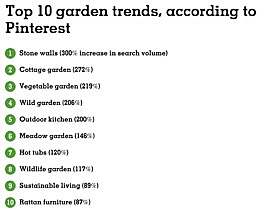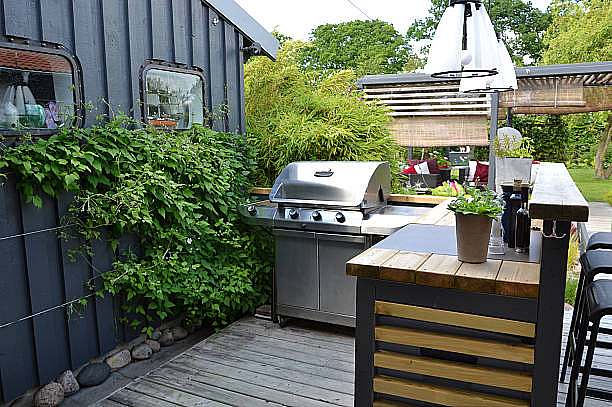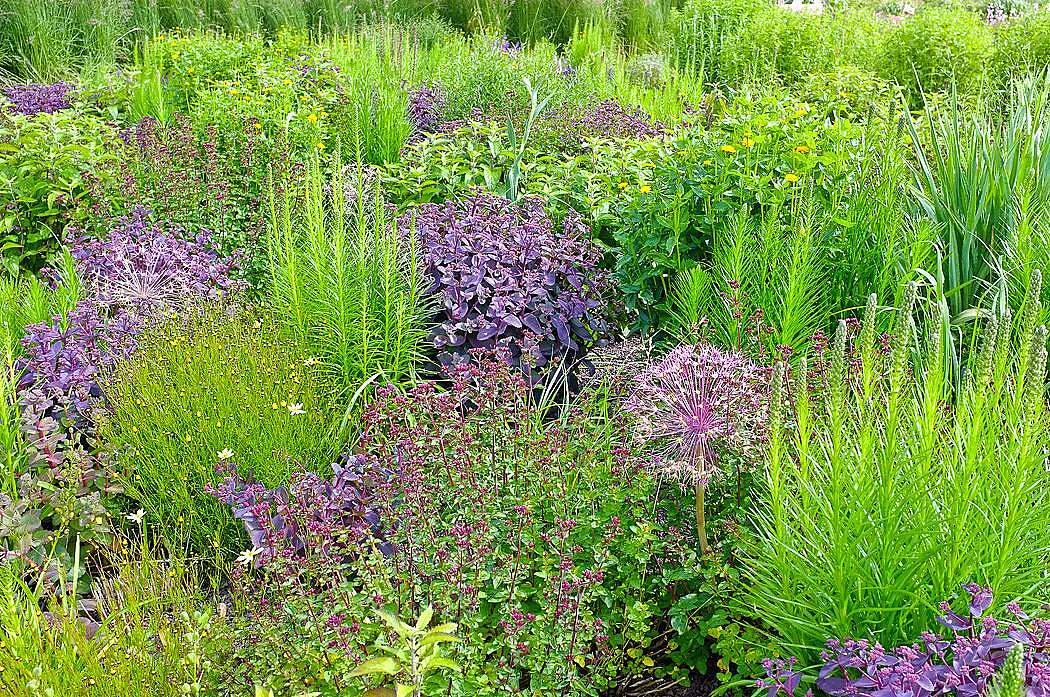Garden Design Trends 2022
Garden Design Trends 2022
Here we gather together some of the predicted garden design trends 2022 and combine them with experience of what we are being asked for by our clients to give our predictions for what we think will be on the rise in 2022.
Garden Design Trends 2022 – #1 Nature Scaping
Pinterest has seen some dramatic changes in search volumes over the past year for ‘wild’ look – with ‘Cottage garden’, ‘Wild garden’, ‘Meadow garden’ and ‘Wildlife garden’ together suggesting a trend towards more ‘naturalistic’ gardens that appear to be ‘of nature’ rather than separate from it and a desire for gardens to actively support wildlife.

One of the silver linings of the Covid-19 Pandemic has been that so many people have come to appreciate the value of gardens and green space in their lives. Perhaps as a result, people are now looking for their gardens to give them a more immersive feeling of being enveloped by nature.
We have had a number of clients ask for a less ‘manicured’ look and some asking for ‘wild flower meadows’. Wild flower meadows can be beautiful and be a valuable source of biodiversity and haven for wildlife. However, whilst they create a ‘wild’ look, this does not necessarily mean that they are maintenance free or that it is easy to create a meadow that will quickly be Instagram ready! There are a couple of things to consider: 1) natural wildflower meadows will usually be growing on land that has not been cultivated and tends to have relatively impoverished soil. In a domestic garden, then soil with normally have been cultivated and enriched with nutrients. If a wildflower seed mix is planted into this garden soil what tends to happen is that grasses dominate and can swamp the wildflower plants. Natural wild flower meadows historically will have had livestock periodically grazing the grass and preventing it from dominating. HRH Prince Charles has created wild flower meadows at Highgrove and they are ‘managed’ by grazing them with sheep at certain times of year. Most people don’t have access to a herd of sheep, so a meadow can be maintained by cutting them back in late summer. This spreads the wildflower seed and allows light to reach the fresh growth. 2) a completely natural wildflower meadow will peak in early summer and will not look very ornamental for the rest of the year. Seed heads will provide food for wildlife, but a mass of dried leaves and stalks may not be what people had in mind when they saw the picture postcard shots of flower meadows on Instagramme!
So how can this natural look be achieved whilst providing a longer period of interest and a sustainable planting scheme that will look good within a domestic garden? One solution is to create what has been called a ‘pictorial meadow’ which consists of a variety of garden perennials, combined to form stable plant communities. This is the approach we are taking when our garden design clients ask for a more wild or naturalistic look. A palette of plants is chosen that will create a particular aesthetic and grow with a similar level of vigour so that one species does not outcompete the others. Specific species are repeated through the planting design. We tend to place plants, according to a loose plan – reinterpreting natural patterns. Perennial meadows can also be planted more randomly using either a seed mix or it is possible to buy meadow turf that has a mix of young plants already established.
For most clients of our clients a garden’s aesthetic is a priority. In 2022 we think we will see more gardens created with this naturalistic aesthetic, but within a strong underlying structure – such as this garden design in Buckinghamshire.
Garden Design Trends 2022 – #2 The garden as an outdoor room

Modern outdoor living:
The pandemic has seen more people ‘staycationing’ and as a result, the focus has turned to having the luxuries that you might ordinarily go away to enjoy, incorporated into your garden. This might include pools, hot tubs, fire pits, outdoor kitchen areas and elements such as lighting to create the feeling of an ‘outdoor room’. Outdoor heaters have seen big increases in sales although we are not big advocates of these, given their environmental footprint.
During the lockdowns there was a boom in the sales of gazebos and shelters and there were market shortages of garden furniture. Outdoor mixing was the norm for a while and we think that the desire to dwell more outside will continue with people wanting to extend the time they can spend in their gardens and expand their use. This might include repurposing an unloved wall into a makeshift cinema screen or transforming a summerhouse into a chill out lounge.
Lawns used to be more of a focal point in gardens but we are increasingly seeing clients either reducing their prominence or being happy to dispense with a lawn (which is actually very high maintenance) completely, in favour of a series of separate ‘garden rooms’ as our gardens double up as work/play/entertainment/recreation areas.
Garden Design Trends 2022 – #3 Gardens for wellbeing
Since the start of the pandemic, our gardens have truly become our sanctuaries. With more time spent at home and the restrictions placed on indoor gatherings, people increasingly looked to gardens, parks and countryside as places to meet and connect with others as well as provide them with a source of comfort in uncertain times. As a consequence of more working from home, we have spent more time spent in front of screens – interacting with the world via Zoom, social media and Netflix. Gardens offer us space to rest and recuperate; as an antidote to our technology-focussed modern life and a way to come back to the fundamentals of life. When we are surrounded by plants we feel cocooned and, in some way, insulated a little from some of the man-made troubles of the World.
The extra time spent at home has enabled us to think about how we connect our indoor and outdoor spaces and to design outdoor living rooms that provide a place to retreat. We see a trend towards not only having a garden as a place to hang out and relax on hot summer days, but a place to reconnect to nature all year round. One of the positive effects of the pandemic is that people now understand the therapeutic effects of gardening and we see people being more mindful and intentional about how they want to feel in their gardens. We love to help our clients create a sense of sanctuary in their garden, to be surrounded by plants and beautiful design – which quieten the mind and feed the soul. We have written elsewhere about the health and wellbeing benefits of gardens as it is something we feel passionate about. We can also recommend an exceptionally well written and researched book called The Well Gardened Mind by Sue Stuart-Smith. At Richard Rogers Designs we have a particularly strong interest in the wellbeing benefits of gardens, which we showcased with our RHS show garden.
Ferns, grasses and evergreens were really popular at the RHS Chelsea Flower Show 2021. Green tends to symbolise renewal, rebirth and stability and we expect that calming and lush green planting will be popular among gardeners looking to create a soothing oasis. This planting style tends to be lower maintenance and will make sense as people head back to the office and may have less time to look after some of the more showy, demanding plants.
Garden Design Trends 2022 – #4 planet friendly gardening
We have seen more clients ask if it possible to recycle materials (e.g. existing paving) within the design. Clients may not see a big cost advantage of doing this, because of the amount of labour involved in, for example, removing old mortar from paving slabs, but reusing existing stone can dramatically reduce the carbon footprint of the garden. A significant proportion of stone comes from countries like India and has involves a lot of machinery to get it out of the ground, shape it and transport it. If recycling isn’t an option, we think that the rising cost of importing goods and the increased awareness of carbon footprint means there will be more emphasis on locally sourced materials, plants and products. Hopefully this will mean more support for UK based nurseries, quarries and craftspeople.
For some time, BBC Gardeners World have been strong proponents of peat free gardening, but it has taken a while for the horticultural industry to let go of their attachment to peat and gear their production towards alternatives. 2021 saw the announcement that the industry must phase out peat completely by 2024.
There will be an increased trend for natural and recycled materials as 2022 will see the introduction of a new plastic packaging tax that will be enforced on all packaging with less than 30% recycled content. You may have noticed the introduction of taupe coloured pots aat garden centres. These are recyclable, unlike the old black pots that recycling machinery could not recognise.
According to Pinterest 2021 saw a 206% increase in searches for ‘wild garden’ and we predict in 2022 that people will start to embrace more of the natural world rather than removing it. When we ask clients about their wishes and desires for their garden, we start by sending them a questionnaire that helps us to get a complete picture of what they want from their garden. Very often people click the option of ‘doing our bit to support wildlife’.
The RHS are championing sustainability and have put together this list of achievable climate actions for gardeners.
Garden Design Trends 2022 – #5 Bolder colours
We were slightly more unsure about this last trend as it sometimes seems strange that a particular colour suddenly becomes fashionable, but a shift towards bolder colours does seem to make some sense, as we rewrite our lives in a post-Covid world. Having had their lives restricted and, in some ways dampened, we feel people will be starting to open up to new possibilities and expressing themselves in more exuberant ways.
According to Pantone the colour of the year 2022 is ‘Very Piri’ which is said to be the happiest and warmest of all the blue hues.

Interestingly sales data from Primrose indicates that forget-me-nots are set to be the most on-trend flower for 2022 and we see Lavenders becoming even more popular.
Historically we have used bold colours more sparingly – as accents within a calmer, more muted colour palette. However, we are starting to use some deeper shades in addition to the more muted colour schemes. For example, we love the dusky pink Echinacea Purpurea, partly because it is such a reliable plant, but some of the bolder Echinacea cultivars are proving to be pretty robust and add some stronger colours without being garish. For example, we have used Echinacea ‘Rainbow Marcella’ and Echinacea ‘Big Kahuna’ successfully.
Lastly, they are not to everyone’s taste, but Dahlias have become increasingly popular as they’re one of the best garden plants to grow for cut flowers. In some parts of the UK they can get through the winter without having to lift them and they can be a great addition to a scheme – especially if one or two varieties are repeated through the planting.
If you would like to discuss how we can help you create your dream garden, perhaps incorporating some of these ideas, we would love to hear from you.
Happy 2022!
